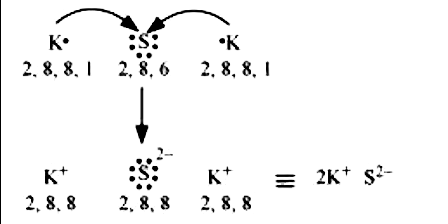Use Lewis symbols to show electron transfer between the following atoms to form cations and anions : (a) K and S (b) Ca and O (c) Al and N.
(a) K and S:
The electronic configuration of K and S are as follows :
K:2,8,8,1
S:2,8,6
K⋅ :..S..:
Sulphur (S) requires 2 more electrons to complete its octet. Potassium (K) requires one electrons more than the nearest noble gas i.e., Argon. Hence, the electron transfer can be shown as:

(b) Ca and O:
The electronic configuration of Ca and O are as follows:
Ca:2,8,8,2
O: 2,6
Oxygen requires two electrons more to complete its octet, whereas calcium has two electrons more than the nearest noble gas i.e., Argon. Hence, the electron transfer takes place as :

(c) Al and N:
The electronic configuration of Al and N are as follows:
Al:2,8,3
N:2,5
Nitrogen is three electrons short of the nearest noble gas (Neon), whereas aluminium has three electrons more than Neon. Hence, the electron transference can be shown as :

Topper's Solved these Questions
Similar Questions
Knowledge Check
Arrange the following atoms in the order of increasing atomic radius : N, B, C, S
AC, S, N, BBS, N, B, CCC, B, S, NDN, C, B, S
Use Lewis dot symbols to show electron transfer between the following atoms to form cations and anions :
(a) NaandCl
(b) KandS
(c ) CaandO
(d ) AlandN
(e ) LiandH
View SolutionUsing Lewis dot symbols, show electron transfer between the following atoms to form cations and anions :
(a) Na and Cl (b) K and S (c ) Ca and O (d) Al and N.
View SolutionWrite Lewis symbols for the following atoms and ions :
S and S2− , Al and Al3+ , H and H−
View SolutionWrite Lewis symbol for the following atoms and ions :
SandS2−, AlandAl3+, HandH−
View SolutionWrite Lewis symbols for the following atoms and ions:
S and S2−,Al, and Al3+,Hand Hө
View SolutionWrite Lewis dot symbols for the following atoms and ions :
(i) SandS2− (ii) PandP3− (iii) AlandAl3+ (iv) HandH− (v) NaandNa+
View SolutionWrite the Lewis dot symbole of the following atoms and ions :
S and S2− ,P and P3− , Na and Na+ , Al and Al3+ , H nad H−
View Solution

